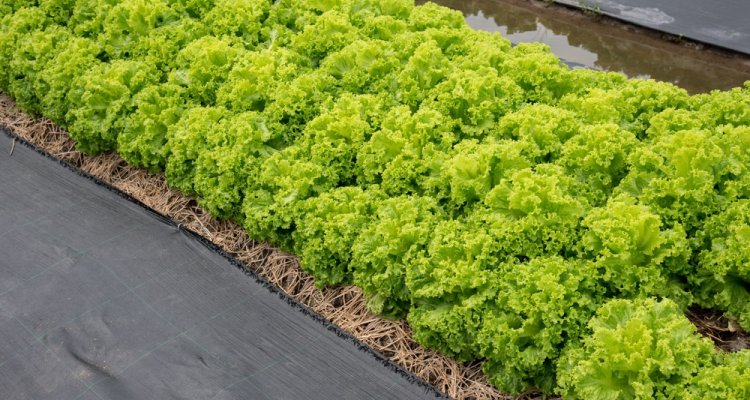
Project
Genetics of lettuce response to abiotic stresses
This project aims to identify and exploit natural genetic variation in the LK500 population to improve lettuce resilience to abiotic stress conditions specifically fluctuating light and tipburn inducing growth conditions while reducing the trade-off towards plant growth.
Background
It is well known that environmental (abiotic) factors such as light intensity, salinity levels and nutrient deficiencies play an important role in plant growth and yield, yet the molecular mechanisms and genetic architecture that underline the responses of plants to said conditions are still largely unknown.
With climate change causing increasingly erratic weather patterns, arable land with ideal environmental conditions is reducing. This all the more necessitates the need to identify stress resilience loci and develop stress resistant crops. An important, yet underutilized avenue that can be used for identification of novel stress resilience loci is by mining the extended germplasm of crops thus exploring and exploiting its existing natural genetic variation. This approach has been used extensively in Arabidopsis thaliana but in the case of lettuce the use has been limited to the search for immunity related traits.
With the advent of high throughput phenotyping technologies that can phenotype a large number of plants continuously across multiple days, phenotyping complex traits linked to abiotic stress can be more robustly captured. This, combined with powerful integrative bioinformatics and machine learning could help describe the genetic background of abiotic stress resilience in lettuce.
Project description
Plants employ various responses to stress conditions. For example optimization of root plasticity in response to salt stress/calcium(Ca) deficiency could affect seedling survival and thereby lettuce resilience and ultimately yield. Another example is the reduction of photosynthetic light use efficiency in response to fluctuating light which detrimentally affects yield as decreased photosynthesis leads to decreased carbon fixation and ultimately decreased biomass(Long et al., 1994). These examples highlight why it is imperative that we study the genetic background behind plant responses to such stresses as they have a direct impact on the yield of the plant. This project primarily focuses on two specific abiotic stressors, namely fluctuating light stress and inner leaf tipburn (associated with inadequate Ca supply in growing tips of young leaves). Simultaneously growth related trade-offs will also be investigated for holistically studying lettuce resilience.
Photosynthesis and tipburn are both complex traits that are affected by multiple factors both biotic and abiotic and therefore can be hard to study in the field but by using high throughput phenotyping under controlled environments (eg:hydroponics climate chamber) these traits can be decoded quite well. To study the natural genetic variation, this project would make use of the LK500 lettuce population panel, a collection of multiple wild and cultivated accessions from four lettuce species, namely 200 Lactuca sativa accessions, 200 Lactuca serriola accessions, 50 Lactuca virosa accessions and 50 Lactuca saligna accessions. Using the lettuce germplasm we will focus on key traits such as photosynthetic efficiency, root/shoot ionome profile, immunity growth trade-off that are key to stress resilience. Using multiple methods including genome wide association studies(GWAS) and RNAseq(ribonucleic acid sequencing), we will identify genes/quantitative trait loci(QTL’s) that are associated with better tolerance to the studied stressors. Such leads can then be used for breeding programs to improve commercial lettuce varieties. With this we hope to shed some light on suboptimal light condition adaptations in lettuce as well as understand the initiation and genetic basis of tipburn in young lettuce plants.
Workplan overview
The heart of this project involves the search for natural genetic variation in the L500 lettuce population panel for better adaptive traits against abiotic stress conditions such as suboptimal incident light(main focus: fluctuating light) and nutrient deficiencies(main focus: tipburn) along with analyzing the growth tradeoffs to the introduction of immunity and extreme R:FR conditions.
The first part of the research project would primarily involve data acquisition. Pilot experiments that would be carried out to ascertain the treatment conditions for the screening of the LK500(primarily Lsat200 and Lser200) and RNAseq experiments. The phenotyping(photosynthetic light use efficiency/plant growth rate/ chlorophyll content etc) will be done using the phenotyping platforms available in WUR and NPEC(namely phenovator-2/robin etc).
Ionome profiling of selected tissue samples from the phenotyping screens will be done in collaboration with The Baxter Lab in St. Louis, Missouri, USA. Furthermore a scoring method for tipburn through image analysis would be investigated. Multiple GWAS would be performed on the data from the screening experiments and the gene candidates thus identified would be compared with the DEG’s from the RNAseq experiment performed under similar treatment conditions. Combined this would give a robust insight into the genes involved in fluctuating light response and tipburn in lettuce. Interesting candidate genes would be further investigated through knockout and complementation studies using in house transformation techniques.
Further molecular and functional characterization of the identified genes in both lettuce and Arabidopsis would follow. It would be investigated in what way do the identified genes play a role in helping the plant acclimatize to the studied stress conditions. The second half of the project would also involve figuring out the correlations between the studied abiotic stresses and if they are involved in overlapping pathways and ultimately how they affect plant growth and on a larger scale the yield(leaf biomass for lettuce) of the plant. This would hopefully give us a holistic picture of how different abiotic stresses affect plant growth in lettuce.